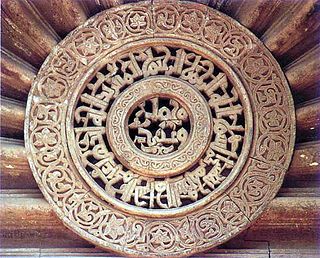
Syedi Abdul Qadir Hakimuddin was a Dawoodi Bohra saint. He is buried in Burhanpur, India. His tomb complex 'Dargah-e-Hakimi' includes mosques, gardens, and visitor accommodations.

Taher Saifuddin, also known as Tahir Sayf al-Din, was the 51st and longest serving Da'i al-Mutlaq of the Dawoodi Bohras. Saifuddin adapted the modernisation in Western and European ideas, and established its benefits for the Bohras, whilst still steeped in the traditions and the culture of the community's Fatimid heritage. Saifuddin laid substantial groundwork in terms of philanthropy, education, entrepreneurship, social outreach, political outreach, and community upliftment upon which his successors, Mohammed Burhanuddin and Mufaddal Saifuddin, continued to build, resulting in unprecedented era of prosperity among the Dawoodi Bohras.

The term Da'i al-Mutlaq literally meaning 'the absolute, or unrestricted, missionary', is the most senior spiritual rank and office in Tayyibi Isma'ilism. The Da'i al-Mutlaq has headed the Tayyibi community since the seclusion of the 21st Tayyibi Imam, at-Tayyib Abu'l-Qasim, traditionally placed in 528 AH/1134 AD.
Galiyakot is a town in Dungarpur District of Rajasthan, India. It is situated about 56 km from Dungarpur city and 168km from the Rajasthan city of Udaipur and is a Dawoodi Bohra pilgrimage site. The town is famous for the tomb of Babjee Moula Syedi Fakhruddin who lived there in the 11th century. Many Dawoodi Bohra Muslims visit the tomb each year to pay homage.

Raudat Tahera is the mausoleum of Taher Saifuddin and his son and successor Mohammed Burhanuddin, the 51st and 52nd Dāʿī al-Mutlaqs of the Dawoodi Bohra Ismaili Muslims. It is located in the Bhendi Bazaar, Mumbai.

Syedna Qutub Khan Qutbuddin as-Shaheed was the 32nd Da'i al-Mutlaq of the Dawoodi Bohra. He succeeded Kasim Khan Zainuddin bin Feer Khan. He was the first Da'i to be martyred for his faith, and in a manner that resembles the martyrdom of Husayn ibn Ali, and so his burial place, Mazar-e-Qutbi, is referred to as Choti Karbala.

Syedna Yusuf Najmuddin Bin Syedna Zakiuddin was the 42nd Da'i al-Mutlaq of the Dawoodi Bohra sect of Musta‘lī Islam. He succeeded the 41st Da'i Abduttayyeb Zakiuddin Bin Badruddin, to the religious post.

Syedna Abdullah Badruddin bin Syedna AbdulHusain Husamuddin ; born 11 July 1846) was an Indian-born religious leader, and the 50th Da'i al-Mutlaq of the Dawoodi Bohra sect. He was the son of Syedna AbdulHusain Husamuddin, whose family lineage can be traced back to Syedi Fakhruddin Shaheed. When the 49th Da'i al-Mutlaq Syedna Mohammed Burhanuddin did nass upon him, all those people who used to say, "After Syedna Mohammed Burhanuddin, the sect would come to an end", could not believe their eyes.

Syedna Noor Mohammed Nooruddin was the 37th al-Dai al-Mutlaq (vicegerent) of the Dawoodi Bohra Community, a subsect of Shia Islam.
Syedna Musa Kalimuddin Bin Syedna Zakiuddin, Jamnagar, India) was the 36th Da'i al-Mutlaq of the Dawoodi Bohra sect of Islam. He succeeded the 35th Da'i Syedna Abduttayyeb Zakiuddin, to the religious post. His period of Dawat was from 1110–1122 AH/ 1692–1711 AD.

Syedna AbdulQadir Najmuddin bin Syedna Tayyeb Zainuddin became the 47th Da'i al-Mutlaq of the Dawoodi Bohra sect amid succession disputes.
The 52nd Da'i al-Mutlaq of the Dawoodi Bohras, Mohammed Burhanuddin died in January 2014. As per the tenets of the sect each predecessor is required to nominate his successor prior to his death. Following his death, a question on succession arose where two rival claimants emerged for the title of 53rd Dā'ī al-Mutlaq: his son, Mufaddal Saifuddin, and his half-brother, Khuzaima Qutbuddin, who was previously Mazoon of the Dawoodi Bohra.
Taher Fakhruddin is the 54th Da'i al-Mutlaq of the Qutbi Bohras, a sect within Shia Islam. He is the son of Khuzaima Qutbuddin, the 53rd Syedna succession controversy. After the death of the 52nd Da'i al-Mutlaq, Mohammed Burhanuddin, due to the succession controversy, one claimant emerged,Khuzaima Qutbuddin. Followers of Khuzaima Qutbuddin regard Taher Fakhruddin as a rightly appointed Da'i al-Mutlaq whereas followers of Mufaddal Saifuddin do not recognise him as the Da'i al-Mutlaq.

Abdeali Saifuddin was the 43rd Da'i al-Mutlaq of the Dawoodi Bohra. He was the son of 41st Da'i al-Mutlaq Abduttayyeb Zakiuddin III and the brother of the 42nd Da'i al-Mutlaq Syedna Yusuf Najmuddin. He was a Dai, scholar and poet and one of the most venerated Dawoodi Bohra Dai's.
Syedna Ismail Badruddin (I) Bin Maulaya Raj was the 34th Da'i al-Mutlaq of the Dawoodi Bohras. He succeeded the 33rd Da'i Feer Khan Shujauddin to the religious post. Syedna Ismail became Da'i al-Mutlaq in 1085AH/1657AD. His period of Dawat was 1065–1085 AH/1657–1676 AD. He is the first Da'i descendant of Moulaya Bharmal.

Syedna Tayyeb Zainuddin Bin Syedi Jivanjee was the 45th Da'i al-Mutlaq of the Dawoodi Bohra sect. He succeeded his brother, the 44th Da'i, Syedna Mohammed Ezzuddin Bin Syedi Jivanjee, to the religious post at the age of 38 years.

Syedna Mohammed Ezzuddin Bin Syedi Jivanjee was the 44th Da'i al-Mutlaq of the Dawoodi Bohra sect. He succeeded the 43rd Da'i, Syedna Abde'Ali Saifuddin, to the religious post at the age of 29. He was born in 1788.

Syedna Mohammed Badruddin was the 46th Da'i al-Mutlaq of the Dawoodi Bohra. He succeeded the 45th Da'i, Syedna Tayyeb Zainuddin, to the religious post. He was born in Bharuch in 1811. He was seven years old when his father Syedna Abde'Ali Saifuddin died. He was taken under the care of Syedna Mohammed Ezzuddin who brought him up and nurtured him for four years.

Aljamea-tus-Saifiyah is an Arabic academy dedicated to Islamic learning based in India, Pakistan, and Kenya. Established in Surat as Dars-e Saifeec. 1810 by Abde'Ali Saifuddin, it was after extensive renovation and expansion carried out by Taher Saifuddin and Mohammed Burhanuddin, the university gained prominence. Today, as holder of the office of Dāʿī al-Mutlaq, Mufaddal Saifuddin is the sole benefactor of the institute.






















